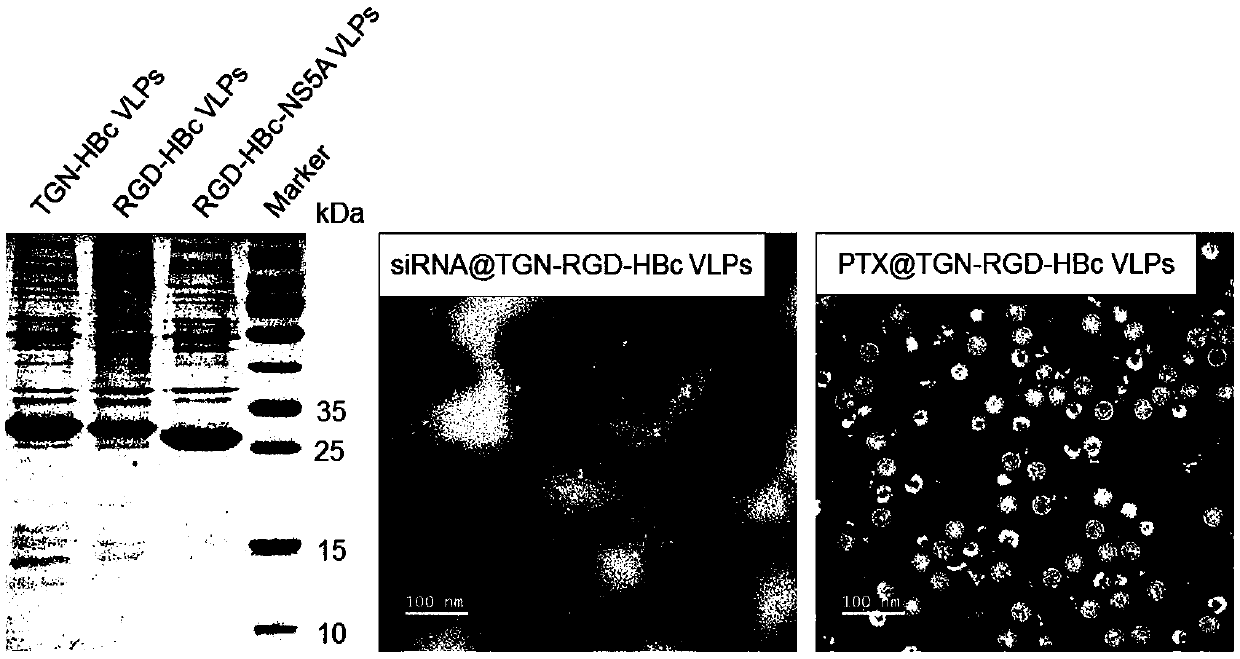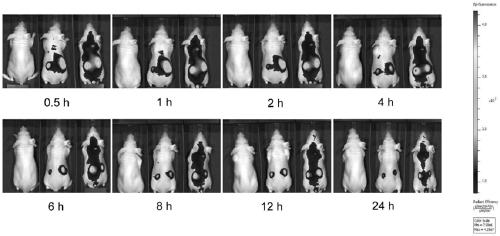Cross-barrier targeted drug delivery system for lesions, drug-carrier system and host cell system
A technology of drug delivery system and carrier system, applied in the field of drug delivery system and host cell system, can solve the problems of mutation and immune response, low transfection efficiency, poor biocompatibility, etc., and achieve good biocompatibility with target cells. Specificity, increase targeting efficiency, increase the effect of flexibility
- Summary
- Abstract
- Description
- Claims
- Application Information
AI Technical Summary
Problems solved by technology
Method used
Image
Examples
Embodiment 1
[0054] Expression and purification of HBc VLPs: Streak or spread the Escherichia coli modified by the target gene on a solid medium, culture it upside down at 37°C overnight, pick a single colony and expand it in 2.5% LB medium until the OD600 reaches 0.6 At −0.8, 0.1 mM IPTG (volume ratio IPTG:LB medium=1:10000) was added to induce culture at 18° C. for 18 h. After the induction, the bacterial liquid was collected, centrifuged at 4000 rpm for 12 min at 4°C, the supernatant was discarded, and the precipitate was collected. The pellet was resuspended with Tris buffer (10 mM Tris-HCl, 0.5% (v / v) Triton-X-100), and the resuspended solution was ultrasonically disrupted until the bacterial solution was not drawn, and the ultrasonic power was 50%. Centrifuge the crushed cells at 4°C and 12000rpm for 30min, collect the supernatant, and slowly add saturated (NH4) 2 SO 4 solution, saturated (NH 4 ) 2 SO 4 The solution accounts for 30% to 40% of the total volume, and the stirring i...
Embodiment 2
[0058] U87 cells were seeded in 96-well plates at a concentration of 5000 cells per well. 100 μL of PTX carrier solution was added to each well, and there were three groups in total: PTX group, PTX@TGN-RGD-HBc VLPs group, and PTX@TGN-RGD-HBc VLPs synergistic siRNA@TGN-RGD-HBc VLPs group (the concentration of PTX was 0.001, 0.01, 0.1, 1, 10 μg / mL). After incubation for 24 hours, discard the supernatant, add 100 μL MTT (5 mg / mL) solution and incubate for 4 hours, discard the supernatant, add 150 μL DMSO, shake on a shaker at 37°C for 30 minutes, and measure the OD value at 490 nm. The result is as figure 2 It was shown that at low concentrations of PTX, the killing effect of the PTX-loaded targeted drug group (PTX@TGN-RGD-HBc VLPs) on cells was not much different from that of the free drug group (PTX), while the synergistic drug group (PTX@TGN-RGD- RGD-HBc VLPs+YAP-siRNA@TGN-RGD-HBc VLPs) showed obvious killing effect. At high concentration, both PTX-loaded targeted drug grou...
Embodiment 3
[0060] An orthotopic glioma model bearing U87 cells was established, and TGN-RGD-HBc VLPs and non-targeting VLPs (HBc-183VLPs) were labeled with Cy5.5, administered through tail vein injection, and the live fluorescence of mice was observed at different time points Distribution. The result is as image 3 As shown, for the pictures at the same time point, the left mouse is the normal saline group, the middle mouse is the non-targeted VLPs group, and the right mouse is the double-targeted VLPs group. according to image 3 The results showed that the distribution of dual-targeted VLPs in the brain was significantly better than that of non-targeted VLPs.
PUM
| Property | Measurement | Unit |
|---|---|---|
| Particle size | aaaaa | aaaaa |
Abstract
Description
Claims
Application Information
 Login to View More
Login to View More - R&D
- Intellectual Property
- Life Sciences
- Materials
- Tech Scout
- Unparalleled Data Quality
- Higher Quality Content
- 60% Fewer Hallucinations
Browse by: Latest US Patents, China's latest patents, Technical Efficacy Thesaurus, Application Domain, Technology Topic, Popular Technical Reports.
© 2025 PatSnap. All rights reserved.Legal|Privacy policy|Modern Slavery Act Transparency Statement|Sitemap|About US| Contact US: help@patsnap.com



